Positive Health Online
Your Country

Chiropractic
listed in chiropractic, originally published in issue 22 - September 1997
During this era the social climate was conducive to the development of unorthodox forms of health care. The most important factor that contributed to the emergence of chiropractic was the medical protest and medical reform movements of this period. At this time medical treatment had little rational basis, consisting mainly of bloodletting and surgery, more often than not causing more harm than good to the patient.
The "founder" of chiropractic, Daniel David Palmer (see Figure 1), was born in 1845, his interest of 19th century medical concepts leading him to become a magnetic healer. The initial question that drove Palmer was, "Why does one man get sick when others who work with him or live in the same house do not? If they eat the same food and breathe the same air why does one person contract a disease and another does not?".
He reasoned that the nervous system controlled and regulated every bodily function, be they micro or macro, and disturbance in the normal function of the nervous system produced dis-ease in the body. He further correlated that the primary cause of dis-ease was the loss of the normal position and movement of a vertebral segment (vertebral dysarthria). This was termed the vertebral subluxation and its neurological manifestations being the most significant of Palmer's concepts.
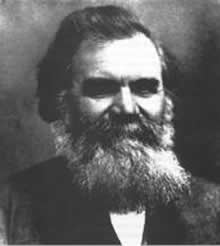
Figure 1 Daniel David Palmer, founder of Chiropractic
There was also another element to the chiropractic philosophy, considered at the time as spiritual, but now recognised by many as simple physiology. Palmer's concept, in this case, included the idea that there must be some underlying force which guides the body physically and mentally. This "vitality" he believed expressed itself in each individual and described it as innate intelligence. Known today as homoeostasis by physiologists, it is this that chiropractors essentially believe is disturbed by the vertebral subluxation, hence allowing the body to start to fail (see Figure 2).
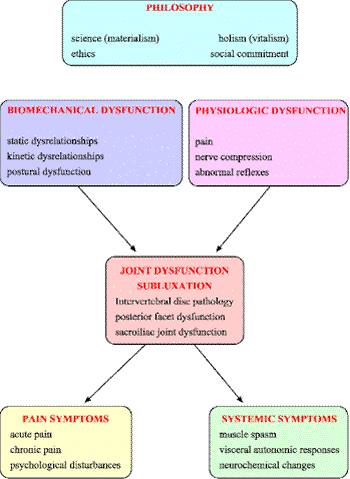
Figure 2 Chiropractic Theoretical Model
The first documented chiropractic adjustment was performed in 1895. Some years earlier the janitor of the building where Palmer practised had hurt his back while "exerting himself in a cramped, stooped position, felt something give way in his back and immediately became deaf." Palmer concluded that if Mr Lillard's deafness of 17 years was linked to his back injury, it could be restored by reversing the process. Mr Lillard received an adjustment to his 4th thoracic vertebra and consequently his hearing was restored.
The early years of the chiropractic profession were not without sacrifice. During its early days chiropractic fought hard against osteopathy and a medical establishment determined to extinguish all traces of its existence. Even in the light of Palmer's son, B. J. being charged for practising medicine without a license and the imprisonment of Palmer himself in 1906, the eagerness of chiropractors was not dispirited. It was then Palmer started travelling the United States for the cause of chiropractic and passed to his son the management of the Palmer Chiropractic School, in Davenport, Iowa.
It was not long before B. J. Palmer become a key figure in the development of chiropractic. In 1909 he introduced x-ray analysis, an element that differentiates chiropractic from other forms of manual medicine.
The availability of x-ray analysis prompted the rapid development of chiropractic adjustive techniques, and many standard radiographic positions for the study of skeletal structures. Now the chiropractor was able to identify destructive bone diseases and other contraindications to manipulation, and secondly he could appreciate the anatomical and structural variants necessary to precisely apply the chiropractic adjustment successfully.
To date, chiropractic and its theories is now one of the most researched professions in the world and there is little doubt that the elements of the vertebral subluxation exist. However, to many in the medical profession, chiropractic is still a long way from being accepted by the mainstream in spite of continued independent trials and reports saying otherwise. Simply because of a confusion in the terminology used to describe a subluxation and the fact that many radiologists deny its existence, as it cannot be demonstrated radiographically, chiropractors have found it extremely difficult to communicate with allied professionals. However, slowly and surely this trend is changing; with steering groups, evidence based government enquiries, and the legislation of chiropractic in most parts of the world. Now in the UK, the General Medical Council and the Royal College of General Practitioners advocate the use of chiropractic, particularly in the management of back pain. Unfortunately for the patient, personal bias is now the main reason for refusing to recognise chiropractors and their work.
Today, chiropractic has celebrated its centenary, knowing that it is taught and practised throughout the world. It has earned broad acceptance for its services, particularly in the arena of neuromusculoskeletal medicine, where chiropractic and its results in managing back pain have been most recently documented. The most comparative trial to date, which compared chiropractic management of low back pain to that of hospital outpatient management (published in the British Medical Journal, 2nd June 1990) showed chiropractic to be significantly more effective, particularly in the management of the long term sufferer of back pain. So much so, the medical researchers concluded that chiropractic should be included in the National Health Service.
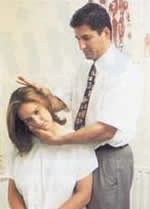
Figure 3 Cervical adjustment
The central art to chiropractic treatment is the spinal adjustment (see Figure 3). This is a specific form of manipulation using varied high velocity, low amplitude, short lever techniques which, when precisely applied, correct the vertebral subluxation and restores joint mobility in the spine. Unlike the early manipulative techniques of the day, where bone setters and early osteopaths used generalised traction and stretching techniques, chiropractors were insistent on specifically applied adjustments. These used the transverse or spinous processes of the spine to direct a precisely controlled technique which is still being refined to this day.
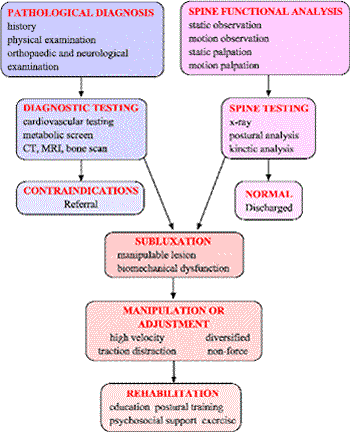
Figure 4 Chiropractic Clinical Model
This adjustment needed a system of analysis to identify the joints at fault (see Figure 4). Initially early chiropractors relied on touch and observation, making note of obvious deviations from the norm, such as deviations in joint position, leg length variants, rotated pelvis, prominent ribs, altered posture and gait, changes in skin temperature and colour, texture of tissue and muscle groups. The introduction of the x-ray analysis enabled chiropractors to be even more specific by actually taking measurements from the radiographs to direct the line of drive the adjustment should take.
As the mechanics of chiropractic technique were revealed there was a move towards the application of a dynamic model to the joints rather than purely a static relationship of one joint to another. This led to the development of motion palpation and the idea of articulating one joint in relation to another. From this was developed the fixation theory of joint mechanics, the foremost practised analysis system in chiropractic today. (see Figures 5 and 6)
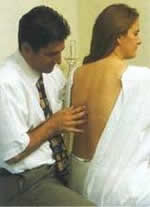
Figure 5 Motion Palpitation
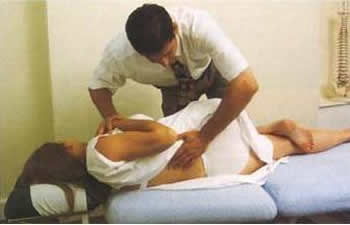
Figure 6 Lx/SI adjusting
Chiropractic today concentrates on the diagnosis and treatment of disorders of the neuromusculoskeletal system. Chiropractors pay particular attention to the spine, as its close relationship to the nervous system involves it in a great number of musculoskeletal pain syndromes and visceral disorders. Approximately 50% of those presenting to a chiropractor are suffering from back and/or leg pain, 40% with neck pain and related shoulder or arm pain, headaches and migraine. The remainder being made up of sports and training injuries, extremity problems and visceral complaints such as asthma, dysmenorrhoea, indigestion and childhood complaints such as colic and nocturnal enuresis.
Probably the most controversial side to chiropractic today is its role in treating sufferers of visceral disorders. Initially the success stories of chiropractic treatment were based on empirical results, but to the scientific world these alone were too subjective. At present all chiropractic colleges throughout the world are running research programmes in the field of chiropractic to satisfy the need for objective reproducible trials and results. The areas of musculoskeletal injury, sports medicine and biomechanics are well developed and now trials in the field of managing visceral disorders are being published. Commonly asthma, dysmenorr- hoea, migraines, infantile colic and sufferers of gastrointestinal disturbances are presenting to chiropractors and it is through the spine's close relationship with the autonomic nervous system that chiropractic adjustments frequently help the sufferer.
Chiropractic management of a patient tends to concentrate on the underlying cause of the dis-ease rather than suppressing the symptoms. By restoring the function to the joints of the spine one achieves a long term functional improvement producing well-being in the patient rather just pain relief. The education of the chiropractor gives him a sound knowledge of not only his chiropractic skills, but also neurology, orthopaedics, radiology, paediatrics, geriatrics, clinical anatomy and physiology.
These are but a few of the subjects examined prior to graduating after 5 years studying for the Post Graduate Diploma in Chiropractic offered by the Anglo-European College of Chiropractic (AECC) in Bournemouth. Following this a further post graduate internship year has to be completed prior to a chiropractor being recognised by the Profession.
With the legislation of chiropractic in the UK, educational and professional standards are to be controlled by a single accredited body. Much like the General Medical Council, the General Chiropractic Council will fulfil this role, protecting title, standardising education, ethics and quality of practice. It is also the profession's aim to set up the College of Chiropractic and gain a royal charter, to run post graduate courses and offer further qualifications such as associate and fellowships, putting chiropractic education in the UK on a par with that of medicine and foremost throughout the world.
Further information
Chiropractic Information Service, 16 Golden Square, London W1. Tel: 020-7434 4100.
British Association for Applied Chiropractic, The Old Post Office, Stratton Audley, Nr. Bicester, Oxon OX6 9BA. Tel: 01869 277111
British Chiropractic Association, Equity House, 29 Whitley Street, Reading, Berks RG2 0EG. Tel: 01734 757557 or Freefone: 0800 212618.
McTimoney Chiropractic Association, 21 High Street, Eynsham, Oxon OX8 1HE. Tel: 01865 880974, Fax: 01865 880975.
Scottish Chiropractic Association, 30 Roseburn Place, Edinburgh EH12 5NX. Tel: 0131-346 7500.
Anglo-European College of Chiropractic, 13–15 Parkwood Road, Boscombe, Bournemoutn, Dorset BH5 2DF. Tel: 01202 436200, Fax: 01202 436312.
Comments:
-
No Article Comments available